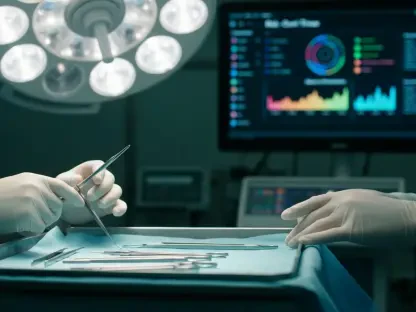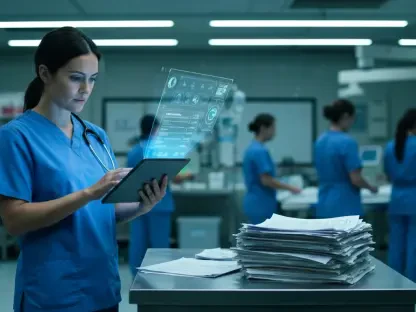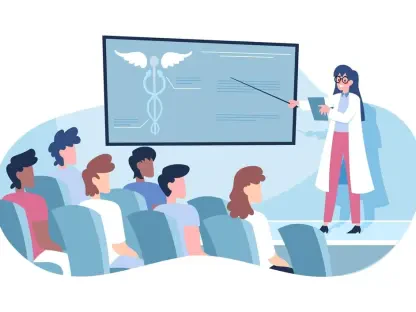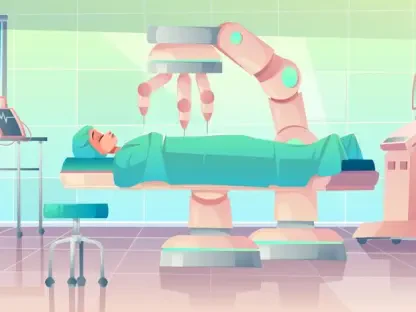The senior care industry is currently grappling with significant staffing challenges, making it imperative to find solutions that can alleviate these issues and improve overall staff engagement. Technology has emerged as a pivotal player in enhancing the work environment for senior care staff, leading to increased job satisfaction, improved morale, and reduced turnover. This article delves into the various ways technology is being integrated within senior care communities to bolster staff support, streamline operations, and ultimately enhance the quality of care provided to residents.
Digital Care Management
Simplifying Daily Tasks
The implementation of digital care management systems within senior care facilities has revolutionized the way staff handle their daily responsibilities. These systems streamline various tasks such as scheduling, tracking resident care, checking resident preferences, and updating health records. By eliminating the cumbersome process of maintaining paper records, digital care systems enable staff to remain organized and efficient, dedicating more of their time to providing direct care to residents.
For instance, a digital app can now easily manage and store comprehensive data about each resident, allowing staff to quickly access critical information. This seamless accessibility prevents potential errors that might arise from misplacing or misinterpreting paper records. Additionally, automated reminders for medication administration and health assessments further simplify daily routines, reducing the risk of oversight. The efficiency brought by digital care management has a profound impact on the staff’s workflow, making them feel more in control and less burdened by administrative tasks.
Reducing Stress and Fostering Teamwork
The transition to digital care management has significantly reduced stress among staff members, as it streamlines workflows and fosters better teamwork. Employees now feel less rushed and more capable of providing high-quality care since they can easily coordinate with their colleagues and access up-to-date information. This positive shift in the work environment has led to lower turnover rates and a stronger sense of team cohesion.
Moreover, digital systems enhance communication within the care team. Staff can quickly update each other on a resident’s condition and share vital information in real-time, ensuring everyone is on the same page. This collaborative approach not only improves the quality of care residents receive but also creates a supportive work culture where staff can rely on one another. Enhanced team dynamics contribute significantly to job satisfaction, as employees feel valued and united in their mission to provide exceptional care.
AI Patient Monitoring and Scheduling
Optimizing Staff Schedules
AI-based tools for scheduling and patient monitoring offer numerous advantages, drastically improving the operational efficiency of senior care facilities. These advanced systems help predict staff availability and anticipate patient needs, leading to optimized scheduling that aligns with individual staff preferences. This improvement ensures that employees are happier with their shifts, which undeniably contributes to higher quality and more efficient work output.
For instance, AI-driven scheduling tools can analyze patterns in workflow and match them with the personal preferences and qualifications of each staff member. This results in more balanced work schedules that distribute the workload evenly and maximize the strengths of the care team. Moreover, automated scheduling reduces the administrative burden on managers, allowing them to focus on strategic improvement initiatives. The overall result is a more satisfied workforce, as well-structured schedules reduce burnout and prevent conflicts that arise from unfair shift assignments.
Prioritizing High-Risk Patients
AI-driven patient monitoring systems analyze data to identify patients most at risk for hospital readmission, allowing staff to prioritize care for these individuals. By providing comprehensive medical histories, these systems minimize errors and enable staff to make informed clinical decisions. Enhanced communication among staff and with external healthcare providers further improves workflow efficiency and reduces stress.
Implementation of AI in patient monitoring means real-time tracking of resident health metrics such as vital signs and behavioral changes. Predictive analytics can alert the care team to potential health issues before they become critical, ensuring prompt intervention. This proactive approach significantly reduces hospital readmissions and fosters a sense of security among staff, knowing they have cutting-edge tools to support their efforts. The increased confidence in their ability to provide exceptional care positively impacts their overall job satisfaction and encourages retention within the facility.
Technology Solutions to Staff Pain Points
Identifying and Addressing Challenges
Addressing specific staff concerns through targeted technological solutions is crucial for enhancing staff satisfaction and retention in senior care settings. By engaging employees in discussions about their pain points, senior care communities can map out current processes, identify gaps, and implement automated solutions to streamline workflows. This collaborative approach leads to improved satisfaction for both staff and residents, as technology directly addresses the practical challenges faced daily.
For example, employees may highlight issues such as time-consuming documentation or inefficient communication channels. By understanding these pain points, management can introduce technology solutions like voice recognition software for faster documentation and integrated communication platforms to enhance connectivity among staff. Such targeted interventions not only improve day-to-day operations but also demonstrate to the staff that their feedback is valued and acted upon, fostering a positive work environment and reducing turnover rates.
Successful Pilot Programs
Pilot programs, such as enhancing the dining reservation system, have proven successful in simplifying operations for both staff and residents. By partnering with external experts, like students from the Indiana University School of Informatics, senior care facilities can gain valuable insights for further advancements in technology usability. These collaborative efforts lead to tangible improvements in daily operations, directly contributing to higher staff satisfaction and better resident experiences.
One successful pilot project might involve using tech solutions to streamline dining arrangements, allowing residents to reserve meal times and select menu options through a digital platform. This not only reduces the administrative load on staff but also enhances the dining experience for residents by minimizing wait times and ensuring dietary preferences are met. Such initiatives reflect the potential of targeted technology solutions to alleviate common pain points, fostering a conducive working environment and promoting resident satisfaction.
Training and Change Management
Encouraging Staff Buy-In
To ensure the successful implementation of new technology, it is essential to involve employees early in the process. Encouraging staff buy-in by explaining the reasons for change and involving them in selecting and refining technological solutions fosters a sense of ownership and ensures smoother transitions. Comprehensive and repetitive training through various methods supports the adoption of new systems.
For instance, holding workshops and interactive sessions where staff can provide input and gain hands-on experience with new tools can be immensely beneficial. By clearly communicating the benefits and addressing concerns upfront, management can ease apprehensions and build enthusiasm for the change. As employees become more familiar with the technology, their confidence in using it grows, significantly enhancing the likelihood of successful implementation and long-term adoption.
Providing Ongoing Support
Offering tutorials and office hours for additional support during the initial stages of implementation helps staff adapt to new technologies more effectively. Understanding the specific problems that need solving and ensuring the technology provides a clear return on investment are crucial steps in successful technology adoption.
For example, continuous support mechanisms like a dedicated helpline or an online resource center with tutorials can provide staff with the necessary assistance as they navigate new systems. Regular feedback sessions should be conducted to address any ongoing issues and refine the implementation process. This approach not only helps in mitigating initial resistance but also encourages a culture of continuous learning and improvement, ensuring the technology’s sustainability and effectiveness in the long run.
Best Practices for Technology Implementation
Regular Evaluation and Adjustment
Implementing new technology in senior care settings requires careful planning and continuous assessment. Regularly evaluating the implemented technology and being prepared to make adjustments as needed is crucial for maintaining its effectiveness. Patience and sustained effort are key to successful change management.
For instance, periodic reviews of technological tools can help identify any glitches or areas for improvement. Engaging with staff to gather firsthand feedback ensures that the technology remains aligned with their needs and evolving workflows. Adjustments based on these evaluations foster a dynamic environment where technology can be continually optimized to provide maximum benefits, thus supporting the overall goal of enhancing staff satisfaction and retention.
Viewing Technology as a Tool
It is important to view technology as a means to simplify tasks and enhance efficiency, rather than as a panacea. Leaders must ensure they understand the issues they are addressing and select technology solutions that deliver tangible benefits. This approach ensures that technology serves its intended purpose without overpromising results.
For example, while AI and digital care systems significantly improve efficiency and patient care, they are not substitutes for human interaction and empathy. Balancing tech-based solutions with personal care approaches ensures that residents receive holistic care, while staff feel supported rather than replaced. This balanced perspective helps mitigate unrealistic expectations and fosters a more pragmatic and effective use of technology in senior care settings.
Consolidated Findings and Trends
Streamlining Workflows
The use of digital care management systems and AI-based scheduling tools helps streamline workflows, reduce stress, and improve efficiency. This, in turn, leads to higher job satisfaction and better staff retention within senior care communities.
Enhancing daily routines through the digitalization of tasks ensures that staff can focus more on resident care and less on administrative burdens. By providing real-time updates and seamless coordination, technology enables a more harmonious and effective work environment. This streamlined workflow reduces the chances of burnout, thereby encouraging staff to remain committed to their roles for longer periods.
Prioritizing Communication
Effective communication is paramount in senior care settings, where miscommunication can have serious consequences. Technology that facilitates communication among staff and with external providers reduces errors and enhances care quality, ultimately leading to better outcomes for residents and higher satisfaction among care staff.
For example, using integrated communication platforms allows for the swift sharing of critical patient information, ensuring continuity of care and minimizing missteps. This enhanced communication network strengthens teamwork and provides a robust support system for staff, further solidifying their commitment to the care community.
Employee Involvement
Engaging employees in identifying pain points and selecting technological solutions fosters a sense of ownership and buy-in. This collaborative approach leads to more successful implementation and greater satisfaction, as staff feel directly involved in the enhancement of their work environment.
For instance, regular feedback sessions and involving staff in pilot programs ensure that the technology introduced is both useful and user-friendly. When employees see their insights and suggestions being implemented, it reinforces their value within the organization and encourages active participation in future initiatives.
Continuous Improvement
Regular assessment and readiness to adjust technology are crucial for maintaining its effectiveness. Pilots and partnerships with external experts can provide valuable insights for continuous improvement, ensuring that technological solutions remain relevant and beneficial.
Engaging with academic institutions or industry experts for periodic evaluations can offer fresh perspectives and innovative solutions. This commitment to continuous improvement not only enhances the operational capabilities of senior care facilities but also signals to staff that their professional development and work experience are prioritized.
Training and Support
The senior care industry is facing substantial staffing challenges, making it essential to identify solutions that can relieve these issues and enhance overall staff engagement. Technology has become a critical factor in improving the work environment for senior care employees, resulting in higher job satisfaction, better morale, and lower turnover rates. This article explores the different ways technology is being integrated into senior care communities to support staff, streamline operations, and ultimately improve the quality of care provided to residents.
In recent years, advancements in technology have transformed how senior care communities operate. For example, electronic health records (EHRs) have simplified documentation processes, allowing caregivers to spend more time with residents instead of dealing with paperwork. Additionally, communication platforms enable staff to collaborate seamlessly, ensuring the efficient delivery of care.
Moreover, technology such as remote monitoring and telehealth services has revolutionized how medical care is administered in senior care settings. These innovations not only improve resident care but also reduce the stress and workload on caregivers, contributing to a more positive work environment.
Additionally, training and development programs delivered through technological platforms can help staff continually enhance their skills and knowledge, leading to greater job satisfaction. Ultimately, the integration of technology in senior care is not just about improving efficiency but also about fostering a supportive and engaging workplace for staff, which in turn benefits the residents.









